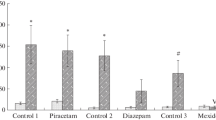Abstract
Rats were trained at a one trial passive avoidance task and were then submitted to electroconvulsive shock or sham electroconvulsive shock. Before training the animals received 100 mg/kg of Piracetam, a non-toxic, non-sedative, non-analeptic drug which has been shown to be active in learning and memory. Control animals received water. Other groups were treated with Piracetam 30 min before the retention test, 24 h after training. Results indicated that the product was active during the retrieval phase of memory, but it did not offer protection from ECS induced amnesia, when administered before training. The results are discussed in relation to other findings with the same drug.
Similar content being viewed by others
References
Bryant, R., Petty, F., Bryne, W.: Effects of Piracetam (SKF 38462) on acquisition retention and activity in the goldfish. Psychopharmacologia (Berl.) 29, 121–130 (1973)
Chorover, S. L., Schiller, P. H.: Short-term retrograde amnesia in rats. J. comp. physiol. Psychol. 59, 73–78 (1965)
David-Remacle, M.: Attenuation of anoxia-induced amnesia by a single pretrial placebo injection. Physiol. Behav. 10, 693–696 (1973)
Eccles, J.: Conscious experience and memory. In: Brain and conscious experience, pp. 314–341. New York: Springer 1966
Glickman, E.: Perseverative neural processes and consolidation on the memory trace. Psychol. Bull. 58, 218–233 (1961)
Giurgea, C.: Vers une pharmacologie de l'activité intégrative du cerveau: tentative du concept nootrope en psychopharmacologie. Actualités pharmacol. 25, 115–156 (1972)
Giurgea, C., Lefevre, D., Lescrenier, C., David-Remacle, M.: Pharmacological protection against hypoxia induced amnesia in rats. Psychopharmacologia (Berl.) 20, 160–168 (1971)
Giurgea, C., Mouravieff-Lesuisse, F.: Effet facilitateurs du Piracetam sur un apprentissage répétitif chez le rat. J. Pharmacol. 3, 17–30 (1972)
Giurgea, C., Moeyersoons, F., Evaerd, A.: A Gaba related hypothesis on the mechanism of action of the antimotion sickness drugs. Arch. int. Pharmacodyn. 166, 238–251 (1967)
Gobert, J. G., van de Walle, A., Close, J.: In vivo modifications of the rat brain metabolism induced by Piracetam. Second part; hypoxied rats (in press)
Gordon, W., Spear, N.: The effect of strychnine on recently acquired and reactivated memories. Physiol. Behav. 10, 1071–1075 (1973)
Hyden, H.: Biochemical changes accompanying learning. In: The Neurosciences, G. Quarton, T. Melnechuk and F. Schmitt, Eds. New York: Rockefeller University Press 1967
Jarvik, M. E.: Effects of chemical and physical treatments on learning and memory. Ann. Rev. Psychol. 1972 457–487
Koppenaal, R., Jogoda, E., Cruce, J. A.: Recovery from ECS produced amnesia following a reminder. Psychonom. Sci. 9, 293–294 (1967)
Lewis, D. J., Bregman, N. J., Mahan, J. J.: Cue dependent amnesia in rats. J. comp. physiol. Psychol. 81, 243–247 (1972)
McGaugh, J.: A multi-trace vue of memory storage processes. Roma: Accademia Nazionale dei Lincei 1968
McGaugh, J. L., Westbrook, W., Hudspeth, W. A.: A further study of learning facilitation with strychnine sulfate. Psychopharmacologia (Berl.) 3, 352–360 (1962)
Misanin, J. R., Miller, R. R., Lewis, D. J.: Retrograde amnesia produced by electroconvulsive shock after reactivation of a consolidated memory trace. Science 160, 554–555 (1968)
Quartermain, D., McEwen, B., Azmita, E.: Recovery of memory following amnesia in the rat and mouse. J. comp. physiol. Psychol. 79, 360–379 (1972)
Sara, S. J.: Recovery form Hypoxia and ECS induced amnesia after a single exposure to the training environment. Physiol. Behav. 9, 85–89 (1973a)
Sara, S. J.: Progressive development of avoidance response after training ECS, and repeated testing. Bull. Psychonom. Soc. 2, 134–136 (1973b)
Sara, S. J., Lefevre, D.: A reexamination of the role of familiarization (FAM) in retrograde amnesia. J. comp. physiol. Psychol. 84, 361–364 (1973)
Spear, N. E.: Retrieval failure in animals. Psychol. Rev. 80, 163–194 (1973)
Springer, A. D., Miller, R. R.: Retrieval failure induced by electroconvulsive shock: Reversal with dissimilar training and recovery agents. Science 177, 628–630 (1972)
Wolthuis, O. L.: Experiments with UCB 6215, a drug which enhances acquisition in rats: its effects compared with those of amphetamine. Europ. J. Pharmacol. 16, 283–297 (1971)
Zinkin, S., Miller, A. J.: Recovery of memory after amnesia induced by electroconvulsive shock. Science 155, 102–104 (1967)
Author information
Authors and Affiliations
Additional information
The authors would like to thank Dr. C. Giurgea for his support and guidance. The Piracetam was kindly supplied by Union Chimie Belge (U.C.B.).
Rights and permissions
About this article
Cite this article
Sara, S.J., David-Remacle, M. Recovery from electroconvulsive shock-induced amnesia by exposure to the training environment: Pharmacological enhancement by Piracetam. Psychopharmacologia 36, 59–66 (1974). https://doi.org/10.1007/BF00441382
Received:
Issue Date:
DOI: https://doi.org/10.1007/BF00441382




